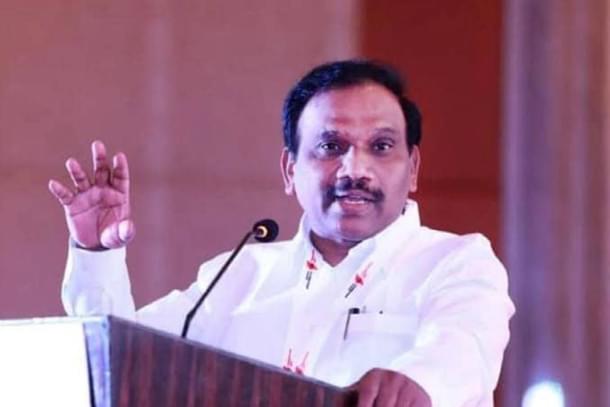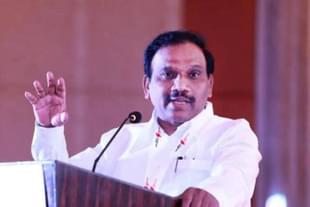Ideas
Hate Speech Of Andimuthu Raja — The Disease Of Self-Hatred
Aravindan Neelakandan
Sep 14, 2022, 04:59 PM | Updated 04:50 PM IST
Save & read from anywhere!
Bookmark stories for easy access on any device or the Swarajya app.


A speech by the Member of Parliament (MP) of Dravida Munnetra Kazhagam (DMK), Andimuthu Raja (A Raja) has gone viral.
In a video clip, the MP tells his audience that "they remain Shudras till they remain Hindus".
Then he goes on to say that Shudra means "son of a prostitute". He also adds that one remains an "untouchable" till one remains Hindu.
Legal action needs to be taken and political awareness needs to be created against such hateful speeches.
The Hate Speech Of Raja Is A Symptom Of A Deeper Malaise
That malaise is the deep, negative stereotype of Hindu Dharma and civilisation and hence the Hindus — that Hindu Dharma divides and demeans people.
As per this line of thought, Hinduism has to be eradicated and destroyed if the ‘Shudras’ and ‘Panchamas’ who have been 'tyrannised' in the name of religion are to be liberated.
This was the colonial argument for colonising India.
Colonising India was hugely profitable for the British. But they had to justify the inhumane crimes committed in the process. As a result, they created this powerful narrative.
They essentialised all the social evils arising out of social stagnation as Hindu Dharma and Indian culture. As against this, they were the enlightened masters with a superior civilisation and religion to emancipate the masses of India.
In reality, they further deepened whatever socio-economic disparities existed in pre-colonial India. They then put the blame on Hindu Dharma.
They criminalised tribes and castes. But the subjugated and persecuted communities were made to think that the British saved them.
The hate narrative which Protestant fundamentalism generated against the Catholic priest-craft in the context of Western Christendom was imported into India and mapped on to the Brahmins.
Despite the fact that Brahmins in India were neither a monolith nor as institutionalised as Catholic priests, they were made the villains.
On to this, the British added that the Brahmins were the outside racial aliens who were here to suppress the dark-skinned snub-nosed natives.
Not surprisingly, the Catholic church too has joined hands with Protestant missionaries in perpetuating this negative stereotype of Hindu society.
Incidentally, both educated Indians and societal vested interests on both sides of the fence in India internalised this narrative. In the two centuries of British education, Indians internalised both genetic racism and karmic racism.
This also sees the convergence of Christian Right-wing and colonised Left-wing.
It is this perversion of a civilisational narrative that enables a hate speech like the one made by A Raja pass.
Social justice has become synonymous with hatred towards Brahmins. Rationalism has become synonymous with hatred towards Hinduism.
This manufactured self-hatred inflicted on Hindu psyche is the disease.
But What Is The Truth?
Smritis, like all medieval and pre-medieval law/canon books world over, do exhibit anti-peasants/Shudras bias.
Like with all pre-modern societies, Indian society also had hereditary occupational groups.
Like all pre-modern societies, Indian society also had social exclusion — in the form of untouchability. It was inhuman definitely, and unjustifiable — but it was not peculiar to Hindu society.
So, when it comes to essentialising a religion, it should not be the common social developments but the peculiar characteristics of those religions or cultures which should be used to define them.
In the case of Hindu Dharma, one can say with evidence that this is the only religion which has repeatedly questioned its own authorities based on its spiritual values.
Europe produced Enlightenment in the late medieval centuries and started dismantling its internal social inequalities through more inhuman trans-Atlantic slave trade, institution of slavery across continents and through colonising of Africa, Asia and Australia.
Then it went on to essentialise its civilisational values as egalitarianism and democracy.
India, throughout the ages, irrespective of its economic conditions or even during invasions and massacres from outside, has consistently questioned its own social hierarchies, power structures and social exclusions.
For Hindu Dharma, this vitality of questioning the social-status quo and power structures comes from its spiritual values.
We have Hindu seers who consider themselves ‘Bhagavatpada’, though in later days the term came to mean only Adi Shankara.
If Purusha Sukta considered Shudras as coming from the feet of the Virat Purusha then the height of piety was demarcated by Hindu civilisation as abiding in that very feet of the divine.
Traditionally Nammazhvar is considered as being born in the fourth varna. The ‘Sadari’ that is placed as a benediction in the heads of all Vishnu devotees in the temples irrespective of their caste or race, is the embodiment of Nammazhvar, also called Sadagopan.
In every Shiva temple one can find Nayanmars standing (and one woman Nayanmar sitting) all grouped as united equally in their Shiva bhakti, irrespective of their birth in different occupational communities and varnas. In Vishnu temples stand the Azhwars, who too belong to diverse communities.
Examples can be multiplied in the spiritual history of India.
Even in the realm of temporal affairs, Hindu Dharma gave the Shudras, who were considered as physical labourers, a great dignity, inner strength and self-respect that they could become not only kings but with pride could declare themselves protectors of Dharma against Islamist onslaught.
One can find the mentions of such inscriptions today in many articles, thanks to a new national renaissance in reclaiming historiography.
Even before the Islamist invasions there had been kings belonging to the fourth varna and they were largely endorsed by a dynamic Hindu Dharma.
For example, the Pithapuram inscription of Prthivisvara belonging to the period 1130 CE states that the dynasty sprung from the feet of Lord Vishnu (like Ganga).
The first king of the dynasty was considered as the adapted son of none other than Yudhishthira. Another inscription, when glorifying the king Prolayaverma states:
From the lotus feet of Vishnu who has lotus-navel, was born for the good of the world the noble fourth caste, virtuous, and illustrious with rich life and divided hundred fold like the sacred Ganga, rich with profuse water and split into hundred branches.
The consistent use of the cleansing and life-giving powers of the Ganga to describe the origin of the fourth varna and not any demeaning self-victimising pathos, shows clearly the emancipatory wisdom and dignity of Hindu social view.
In declaring Shudra ancestry as being the locomotive power of society, one inscription stands out — Akkalpundi grant of Singaya Nayak:
The Brahmanas and next the Kshatriyas and Vaisyas were produced from the face, arms and the thighs of Iswara and for their support the fourth Varna. That this Varna is purer than the other three is itself evident, for verily this (Shudra) Varna was born along with the river Bhagirathi (the Ganga which sprang from Vishnu's feet - the purifier of the three worlds). The members of this Varna are eagerly attentive to their duties, not wicked, pure-minded and devoid of passion and as such they only bear the burden of protecting the earth by helping those born in the kingly Varna. The cycle of Krita and other Yugas is rolling like the circumference of a wheel, the protectors of the earth are so likewise.
The fourteenth century inscription shows self-dignity coupled with a deeper historical and more realistic understanding of Hindu society and its values.
The twenty first century speech of A Raja shows servitude to colonial worldview, inability to think for oneself and a tendency to derive a 'cheap thrill' by immersing oneself in the stagnant and putrid waters of hatred. It shows a deep self-loathing and sense of inferiority that a colonised mind possesses.
The fourteenth century inscription shows a premonition of many modern social theories that a modern student would associate only with the twentieth century. At the same time from this inscription one can draw a connection to the social views expressed by Swami Vivekananda, Sri Aurobindo, Mahatma Gandhi and Dharampal.
The twenty first century speech of A Raja shows a thread connecting himself to the colonial exploiters of Indian society in the past and if the same thread is extended to the future, then it extends into a kind of hate-realm that was inhabited by leaders like Hitler, Mao and Stalin.
Andimuthu Raja is a victim of his own colonial conditioning and hatred.
The Disease Needs To Be Contained And The Affected Need Curing And Healing
We need to change the narrative of history from the colonial preconceptions and bygone racial, essentialist frameworks to holistic, hard-data driven indigenous Indic frameworks.
The thread connecting the Vedas-Upanishads to Bhakti Movement to the fourteenth century inscriptions to Swami Vivekananda and Sri Aurobindo, Mahatma Gandhi and Dharampal is one approach Indian historiography can take.
The narrative of colonial stereotypes and the pseudo-rationalist, racist worldview of Dravidianism as demonstrated by Andimuthu Raja is another approach.
It is not hard to see what kind of historiography has to be nurtured and which should be allowed to reach its natural destination to the dustbin of history.
Aravindan is a contributing editor at Swarajya.




